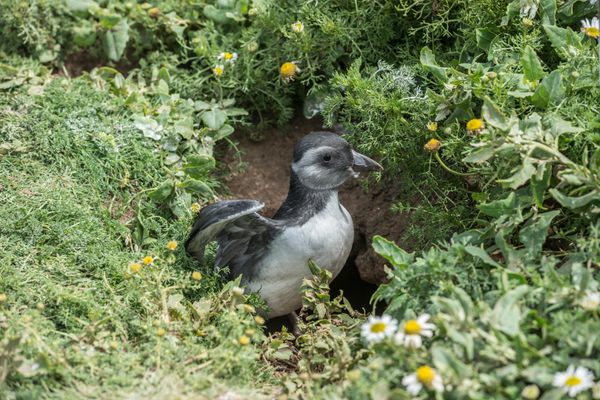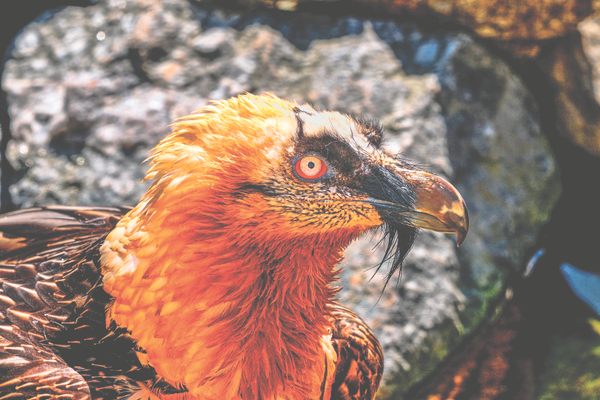How to Make Friends With a Bird
Learn how to share space with modern dinosaurs thoughtfully—without, you know, just winging it.
You’re kicked back in a camp chair, daydreaming about flapjacks and watching the breeze blow through the leaves, when you catch movement in your peripheral vision. You cautiously turn your head to see the prowler. It has feathers, and it’s looking right at you.
Quick, what do you do?
Start by resisting the urge to reach for your cell phone, says naturalist David Mizejewski, with the National Wildlife Federation. “You’re only going to see this animal for just a few seconds, so just enjoy and observe. Don’t bother getting what will likely be a blurry subpar photo and miss out on the moment.”
But what if you crave a more meaningful, extended kinship with a wild flier? If so, you’re not alone. According to a survey by the U.S. Fish & Wildlife Service, birdwatching—at home or further afield—is the top wildlife viewing activity, with more than a third of American adults (about 96 million people!) participating each year. Whether you relate more to lanky, stoic herons or irresistible puffball birbs, here’s how to make friends with one, on its terms, on its home turf.

Get up early
Many birds are most active around dawn, while they’re singing and starting their day. They also tend to reemerge in late afternoon.
Be chill
Remember, you’re in their home, so be mindful of your behavior and don’t come off as a threat. Minimize your presence by being as quiet and still as possible, wearing muted colors, and, when you do have to move, doing so in a slow and calm way.
Think like a bird
Especially if you’re trying to find a particular species, learn where they want to be. For example, hummingbirds enjoy meadows on the edge of woods, while kingfishers love streams where they can splash around for a fishy feast.
Let birds come to you
Find a good vantage point and wait patiently. “If you give it space, it’ll probably settle in and go about its day-to-day behaviors,” says nature educator, speaker and author Ken Keffer, who also owns the Wild Birds Unlimited in Bloomington, Indiana. “You don’t want to push it too hard or it’s gonna fly away, and you’re not going to be able to keep up with it.”
Be a good listener
In the woods, chances are you’ll hear a lot more birds than you see, so don’t forget to use your ears. “Unlike mammals, which are relatively quiet, birds are loudmouths,” says Mizejewski. “You can’t shut them up.” One easy bird to identify by its vocalization is a robin. Listen for “cheerio, cheerio, cheerio.” And when you’re at the campfire, don’t forget to keep an ear out for the owls.
Bring curiosity
Noticing bird behavior can help identify the species. For example, on their quest to reach bugs in a tree trunk, woodpeckers pound straight on, nuthatches spiral headfirst downward, and creepers spiral up.
Start a conversation
Birds are naturally curious, and some will respond to pishing, which is a buzzy noise people make by puckering their lips and blowing out: “psssh, psssh, psssh,” or “ksssh, ksssh, ksssh.” While there are phone apps that play bird noises, they distract the birds from their day-to-day activity—a matter of survival—and should not be used.

Solidify the friendship
Given enough time, many birds will get at least a little acclimated to having you around. Some, like crows, are known to remember faces, and jays are particularly fun. “They’re just a real curious critter that comes to investigate what’s happening,” says Keffer.
Be a polite guest
Avoid activities that stress birds, especially getting too close to nests. If parents get nervous and fly off, it alerts predators to eggs or chicks. Before cutting down a dead tree, check for nests, woodpecker cavities, or branches that could be used as roosts. Keep dogs leashed, especially in areas with nesting ground birds. And don’t blast the tunes. Birds need to hear predators, communicate with mates, and forage for insects for their chicks without distraction.
Don’t offer bribes
It’s okay to feed birds in your backyard, because they are choosing to visit. But when you’re their territory, feeding them poses dangers. It habituates them to humans, which can put them in the way of traffic and other dangers. It can also make them sick. Leaving food out also attracts rodents, which become a nuisance to future campers.
Don’t be clingy
Before you’ve worn out your welcome, let birds get back to their business. Especially take the hint if they are swooping or squawking at you, or seem otherwise irritated by your presence.
Identify your friends
Many people find it fulfilling to match birds with their scientific or common names. But that’s optional. “You can just go out there and be like, I saw a really cool bird that was beating its head on the side of a tree. Might have been a woodpecker, or maybe not,” says Keffer.
If you do want to get into bird identification, Keffer and Mizejewski both recommend the Merlin app by the Cornell Lab of Ornithology, which can help you identify a bird based on look and sound (like a Shazam for bird calls). You can also pick up a good field guide and join community science and conservation programs, documenting your findings on Feederwatch, eBird and iNaturalist. And don’t forget to bring along a pair of binoculars (or binos, in bird nerd lingo). Now get out there and make some new friends.























Follow us on Twitter to get the latest on the world's hidden wonders.
Like us on Facebook to get the latest on the world's hidden wonders.
Follow us on Twitter Like us on Facebook